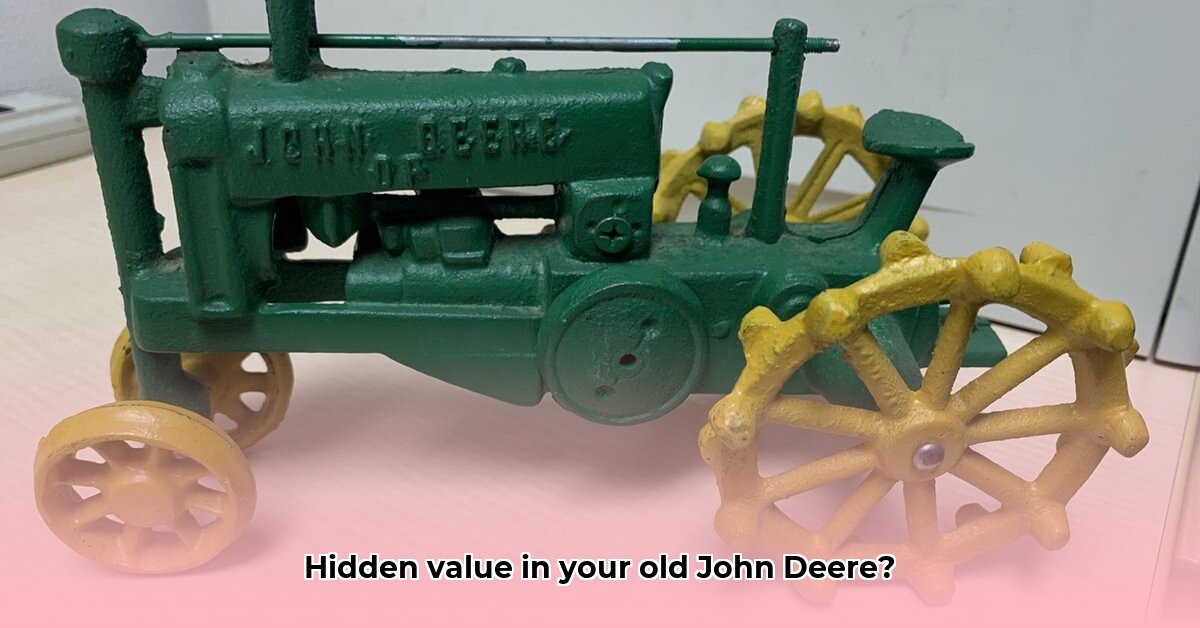
Understanding the Antique John Deere Toy Tractor Market
The world of vintage John Deere toy tractors is a captivating blend of nostalgia, history, and surprisingly lucrative collecting. These aren't just childhood playthings; they are miniature pieces of Americana, reflecting decades of agricultural innovation. But navigating this market requires more than just a fondness for green and yellow. This guide equips you with the knowledge needed to become a savvy buyer or seller. Did you know that the condition of the original box can dramatically impact a tractor's value? A pristine tractor in its original box can fetch significantly more than a similar model with even minor damage. For more in-depth information, check out this helpful resource.
The value of an antique John Deere toy tractor isn’t solely determined by its age. Several factors significantly influence price. Condition is paramount; a flawless tractor in its original box commands a far higher price than one with scratches, faded paint, or missing parts. Rarity is equally crucial; limited-production models are highly sought after by collectors. Even the original packaging—box, inserts, and accompanying materials—can dramatically affect value. Online marketplaces, such as eBay, serve as primary hubs for trading these collectibles, offering convenience but requiring heightened vigilance due to the presence of counterfeit items.
We often hear "antique" and "vintage" used interchangeably, but there are nuances. While precise definitions vary within the hobby, a useful distinction is:
- Antique: Generally, tractors produced before the 1940s. Their age and scarcity often translate to higher prices.
- Vintage: Tractors from the 1940s to the present. Value depends heavily on model, condition, and desirability.
| Term | Approximate Age Range | Market Implications |
|---|---|---|
| Antique | Before 1940s | Higher potential value due to age and rarity; often commands higher prices. |
| Vintage | 1940s - Present Day | Broader range of values; significantly influenced by model, condition, and desirability. |
Identifying Your Antique John Deere Toy Tractor
Becoming a knowledgeable collector requires honing your identification skills. This involves understanding the tractor's era, model, and condition.
1. Pinpointing the Era:
- Pre-War (before 1940): Simpler designs and materials; age and scarcity boost value.
- Post-War (1940s-1970s): Design evolution; wider model variety and price range.
- Modern (1980s-Present): Generally more common and less valuable than older counterparts.
2. Uncovering the Model:
Thorough research is key. Explore online resources, specialized books, and connect with collectors online. Knowing the model number (like a car's VIN) is crucial. Pay close attention to shape, size, features, mold marks, and logos. Subtle differences significantly impact value.
3. Assessing Condition: A Collector's Checklist
Condition assessment is critical. Consider:
- The Box Factor: Is the original box present and in what condition? An immaculate box significantly increases value. A damaged or missing box significantly reduces value.
- Paint Perfection: Examine the paint carefully. Original, oil-based enamel ages differently than later acrylic paints. Minimal wear is preferable.
- Functionality: Does the tractor function as expected for its age? Full functionality enhances value, especially for older models.
- Overall Condition: Assess overall condition, including repairs or alterations. Original, unrestored pieces usually command top prices.
A standardized condition grading scale (like those used for coins or stamps) can be extremely beneficial.
Navigating Future Trends in the Antique John Deere Toy Tractor Market
The future of antique John Deere toy tractor collecting looks promising. Sustained collector interest suggests long-term growth potential. However, external economic factors impact prices. Collectors should diversify their holdings. Focusing on currently undervalued models might mitigate risk. Sellers should adapt by offering competitive pricing and diverse payment options. Monitoring market trends through online sales data and collector forums is crucial.
Dr. Amelia Hernandez, Agricultural Historian at the National Museum of Agriculture, notes, "The enduring appeal of these toy tractors lies in their connection to a rich agricultural heritage and a simpler time. This nostalgic appeal is a significant driver of market value."
Practical Steps for Collectors and Sellers
For Collectors:
- Network: Join online forums and collector groups.
- Become an Expert: Research models, production dates, and condition variations.
- Strategic Acquisition: Don't buy impulsively; focus on models that align with your collecting goals and budget.
For Sellers:
- Detailed Descriptions: Provide accurate descriptions and high-quality photographs.
- Smart Pricing: Research comparable sales to determine a competitive price.
- Prove Authenticity: If possible, provide documentation to verify authenticity.
The market for antique and vintage John Deere toy tractors offers a rewarding combination of nostalgia and investment opportunity. Combining passion, knowledge, and strategy leads to success.